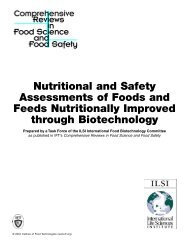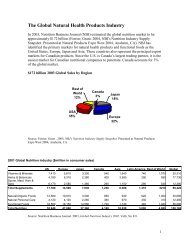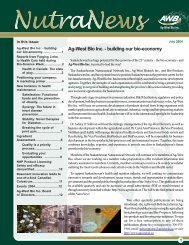Beyond Borders: Global biotechnology report 2010
Beyond Borders: Global biotechnology report 2010
Beyond Borders: Global biotechnology report 2010
You also want an ePaper? Increase the reach of your titles
YUMPU automatically turns print PDFs into web optimized ePapers that Google loves.
exercises the option, it typically takes<br />
responsibility for further development<br />
and commercialization. As noted in the<br />
Financing article (“A higher bar”), the<br />
Novartis Option Fund has also been active<br />
with similar arrangements. The Novartis<br />
Option Fund is, however, investing as a<br />
financial investor first, and normally does<br />
not take on option on the biotech company’s<br />
lead program.<br />
In prior years, we have discussed another<br />
type of option arrangement — the structure<br />
used by Symphony Capital to strike deals<br />
with several biotech firms — as a financing<br />
transaction. In these deals, the biotech<br />
company contributes assets to a newly<br />
formed entity that is funded and controlled<br />
by Symphony, but it retains an option to<br />
acquire the new entity or individual assets<br />
over a defined time period. The success of<br />
the Symphony funding model depended in<br />
part on a healthy equity market so that the<br />
biotechs could access capital to exercise<br />
the options at higher valuations than when<br />
the structure was put in place. Given the<br />
more restrictive fund-raising environment<br />
in 2009 and the fact that even positive<br />
clinical news didn’t always move a<br />
company’s stock, Symphony renegotiated<br />
the option terms of several existing deals<br />
in 2009, including those with Alexza<br />
Pharmaceuticals, Dynavax and OXiGENE,<br />
thus becoming a significant equity holder<br />
in these companies.<br />
Tying the knot<br />
Over its 20-year history, the<br />
Roche-Genentech alliance was incredibly<br />
productive for both parties. We have often<br />
wondered why we haven’t seen more<br />
examples of such deal structures — once<br />
referred to as “the 60% solution” in<br />
honor of Roche’s ownership stake in<br />
Genentech — as it allowed Genentech to<br />
grow and adapt largely insulated from<br />
short-term stock market pressures.<br />
In last year’s <strong>report</strong>, we featured an<br />
innovative partnership between Purdue<br />
Pharmaceuticals (and affiliates) and Infinity<br />
Pharmaceuticals that was intended to<br />
achieve the same objective — albeit with<br />
Purdue holding a minority ownership<br />
interest. With a secure source of financing,<br />
the transaction allows Infinity to allocate<br />
resources to the most promising product<br />
candidates, which may not always be the<br />
most advanced items in their pipeline.<br />
A 2009 version of this structure can be<br />
found in the expansion of an existing<br />
alliance between sanofi-aventis and<br />
Regeneron which is focused on the<br />
development of monoclonal antibodies.<br />
Under this arrangement, sanofi-aventis<br />
will pay Regeneron US$160 million<br />
per year over seven years to conduct<br />
research activities. Sanofi-aventis has<br />
the option to take over development of<br />
the resulting product candidates as they<br />
enter clinical trials. The parties share<br />
the profits from the resulting drugs, with<br />
sanofi-aventis receiving a preferential<br />
profit split until reimbursed for half of the<br />
clinical development costs of the product.<br />
This allows Regeneron to focus on early<br />
discovery and preclinical activities and<br />
only pay for clinical development of drugs<br />
that are approved. Of course, Regeneron<br />
can agree to take on clinical development<br />
for any drug that sanofi-aventis takes<br />
a pass on. Sanofi-aventis is also a 19%<br />
shareholder in Regeneron, but its stake<br />
cannot exceed 30% without approval<br />
from Regeneron. Like the Purdue-Infinity<br />
transaction, the deal does not give sanofiaventis<br />
any board seats. (For more on<br />
the motivation behind this transaction<br />
see “Succeeding together” by Leonard<br />
Schleifer, Regeneron’s CEO.)<br />
While not all biotech companies will have<br />
the technology platform for this type of<br />
arrangement, those that do may want to<br />
consider the option of “getting engaged”<br />
with a larger, patient and strategically<br />
aligned partner.<br />
United States<br />
M&As<br />
The saga of Roche’s acquisition of the<br />
minority interest in Genentech finally came<br />
to close in March 2009 when the biotech<br />
company’s board agreed to a price of<br />
US$95 per share, or nearly US$47 billion<br />
(more than Merck paid for all of<br />
Schering-Plough). This deal closes the<br />
book on the most successful and lucrative<br />
alliance in the history of the biotech<br />
industry. Because of the outsized nature of<br />
the deal and the fact that Roche previously<br />
controlled a majority of Genentech, we<br />
have decided to omit the transaction from<br />
the analysis and charts in this article.<br />
81








